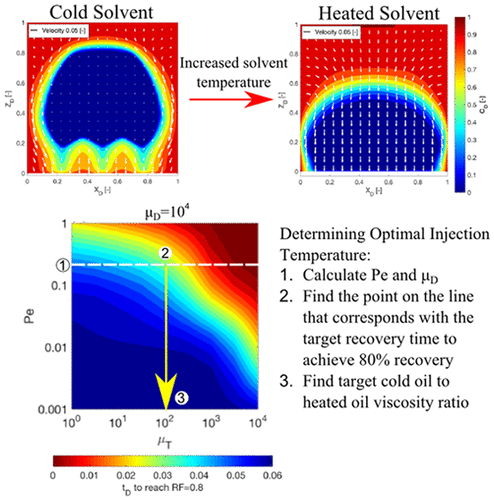当前位置:
X-MOL 学术
›
Ind. Eng. Chem. Res.
›
论文详情
Our official English website, www.x-mol.net, welcomes your
feedback! (Note: you will need to create a separate account there.)
Hot Solvent-Assisted Gravity Drainage in Naturally Fractured Heavy Oil Reservoirs: A New Model and Approach to Determine Optimal Solvent Injection Temperature
Industrial & Engineering Chemistry Research ( IF 3.8 ) Pub Date : 2018-02-16 00:00:00 , DOI: 10.1021/acs.iecr.7b04862 Joseph Sherratt 1 , Amin Sharifi Haddad 1 , Roozbeh Rafati 1
Industrial & Engineering Chemistry Research ( IF 3.8 ) Pub Date : 2018-02-16 00:00:00 , DOI: 10.1021/acs.iecr.7b04862 Joseph Sherratt 1 , Amin Sharifi Haddad 1 , Roozbeh Rafati 1
Affiliation

|
Hot solvent-assisted oil recovery is a low emission-intensity oil recovery method from heavy oil resources. This method is particularly promising for fractured reservoirs where the application of current thermal methods may involve challenges associated with heat loss and early breakthrough. In this study a new model of heat and mass transfer for oil recovery from a single matrix block of a naturally fractured reservoir using a hot miscible solvent is developed. Because of the difference in magnitude between thermal and mass diffusivities, heat diffuses beyond the solvent–oil interface and there is no significant convective heat transfer. This results in a reduction of oil viscosity in the center of the matrix block and a vertical convective flow pattern instead of a pattern parallel to the oil–solvent interface observed during cold solvent injection. Using this model, optimization graphs are developed to perform a fast qualitative assessment of the applicability of a hot solvent-assisted gravity drainage process in naturally fractured reservoirs with various parameters without the need of complex simulations and experiments. An algorithm is presented to estimate the recovery time or target injection temperature of potential hot solvent-assisted oil recovery processes using these optimization graphs. This can reduce computational time and provide a quick evaluation of the hot solvent-assisted gravity drainage process in naturally fractured heavy oil reservoirs.
中文翻译:

天然裂缝性稠油油藏中的热溶剂辅助重力排水:确定最佳溶剂注入温度的新模型和方法
热溶剂辅助采油是一种从重油资源中回收低排放强度的油的方法。这种方法对于裂缝性油藏特别有希望,因为在这种情况下,当前热法的应用可能会带来与热量损失和早期突破有关的挑战。在这项研究中,开发了一种新的传热传质模型,该模型利用热混溶性溶剂从天然裂缝储层的单个基质区块中采油。由于热扩散率和质量扩散率的大小不同,热扩散到溶剂-油界面之外,并且没有明显的对流传热。这会导致基质块中心的油粘度降低,并且垂直对流流动模式,而不是在冷溶剂注入过程中观察到的平行于油-溶剂界面的模式。使用该模型,可以开发优化图,以快速定性评估热裂隙辅助储层中具有各种参数的热溶剂辅助重力排水过程的适用性,而无需复杂的模拟和实验。提出了一种使用这些优化图来估算潜在的热溶剂辅助采油工艺的恢复时间或目标注入温度的算法。这样可以减少计算时间,并且可以快速评估天然裂缝性稠油油藏中的热溶剂辅助重力排放过程。开发了优化图以快速定性地评估具有各种参数的天然裂缝储层中热溶剂辅助重力排水过程的适用性,而无需复杂的模拟和实验。提出了一种使用这些优化图来估算潜在的热溶剂辅助采油工艺的恢复时间或目标注入温度的算法。这样可以减少计算时间,并可以快速评估天然裂缝性稠油油藏中的热溶剂辅助重力排放过程。开发了优化图以快速定性地评估具有各种参数的天然裂缝储层中热溶剂辅助重力排水过程的适用性,而无需复杂的模拟和实验。提出了一种使用这些优化图来估算潜在的热溶剂辅助采油工艺的恢复时间或目标注入温度的算法。这样可以减少计算时间,并且可以快速评估天然裂缝性稠油油藏中的热溶剂辅助重力排放过程。
更新日期:2018-02-17
中文翻译:

天然裂缝性稠油油藏中的热溶剂辅助重力排水:确定最佳溶剂注入温度的新模型和方法
热溶剂辅助采油是一种从重油资源中回收低排放强度的油的方法。这种方法对于裂缝性油藏特别有希望,因为在这种情况下,当前热法的应用可能会带来与热量损失和早期突破有关的挑战。在这项研究中,开发了一种新的传热传质模型,该模型利用热混溶性溶剂从天然裂缝储层的单个基质区块中采油。由于热扩散率和质量扩散率的大小不同,热扩散到溶剂-油界面之外,并且没有明显的对流传热。这会导致基质块中心的油粘度降低,并且垂直对流流动模式,而不是在冷溶剂注入过程中观察到的平行于油-溶剂界面的模式。使用该模型,可以开发优化图,以快速定性评估热裂隙辅助储层中具有各种参数的热溶剂辅助重力排水过程的适用性,而无需复杂的模拟和实验。提出了一种使用这些优化图来估算潜在的热溶剂辅助采油工艺的恢复时间或目标注入温度的算法。这样可以减少计算时间,并且可以快速评估天然裂缝性稠油油藏中的热溶剂辅助重力排放过程。开发了优化图以快速定性地评估具有各种参数的天然裂缝储层中热溶剂辅助重力排水过程的适用性,而无需复杂的模拟和实验。提出了一种使用这些优化图来估算潜在的热溶剂辅助采油工艺的恢复时间或目标注入温度的算法。这样可以减少计算时间,并可以快速评估天然裂缝性稠油油藏中的热溶剂辅助重力排放过程。开发了优化图以快速定性地评估具有各种参数的天然裂缝储层中热溶剂辅助重力排水过程的适用性,而无需复杂的模拟和实验。提出了一种使用这些优化图来估算潜在的热溶剂辅助采油工艺的恢复时间或目标注入温度的算法。这样可以减少计算时间,并且可以快速评估天然裂缝性稠油油藏中的热溶剂辅助重力排放过程。











































 京公网安备 11010802027423号
京公网安备 11010802027423号